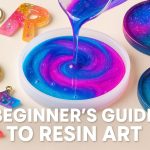Free & Easy Epoxy Resin Calculator
Tired of wasting expensive resin or, worse, running out mid-pour? Take the guesswork out of your art with the ResinStart Calculator. This free and simple tool helps you calculate the exact volume of epoxy resin needed for any project, ensuring a perfect, stress-free pour every time. Choose your Shape, enter the dimensions, and let us do the math for you!
Here’s What You’ll Need:
How to Use Our Resin Calculator
Getting a precise measurement is simple:
- Select the Shape that best matches your mold (e.g., a coaster is a cylinder).
- Measure the INSIDE of your mold carefully using a ruler or measuring tape. For height, this is the depth you plan to pour.
- Select your units (cm or inches) and enter the dimensions into the corresponding fields.
- Select the Mix Ratio specified by your resin manufacturer (usually 1:1 for art resins).
- Click “Calculate” and get the exact amounts you need to mix for a perfect project!
Why Accurate Calculation is a Game-Changer
A good calculator isn’t just about convenience; it’s about better art. Here’s why precision matters:
- Avoids Expensive Waste: Never again mix way too much resin that ends up in the bin.
- Ensures a Perfect Cure: Using the correct resin-to-hardener ratio is critical. Our calculator helps you start with the correct total volume, ensuring your ratios are more accurate.
- Saves You Money: By using only what you need, your resin bottles will last longer.
- Boosts Your Confidence: Removing the guesswork allows you to focus on the fun part—being creative!
Pro-Tips for Perfect Measurements
- The Water Trick (for Irregular Shapes): If your mold has a weird shape (like a crystal or an animal), fill it with water to your desired pour height. Then, pour that water into a measuring cup. The volume of the water is the exact total volume of resin you need!
- Always Mix a Little Extra: We always recommend adding 5-10% to your final calculated volume. This covers the small amount of resin that will inevitably stick to your mixing cup and stir stick.
- Inside Dimensions Only: Remember to measure the internal dimensions of your mold, not the outside.
Frequently Asked Questions (FAQ)
What if my mold has an irregular shape that isn’t listed?
That’s a great question and a very common scenario! For any complex or irregular shape (like a crystal, an animal, or a free-form geode), the most accurate method is the “Water Trick.”
- Place your mold on a level surface.
- Carefully fill it with water up to the level at which you plan to pour your resin.
- Pour that water from the mold into a measuring cup.
- The volume of the water you measured is the exact total volume of resin you need. You can then use the “Custom Volume” option in our calculator to get the breakdown for Parts A and B!
Does this calculator work for both UV Resin and Epoxy Resin?
This calculator is specifically designed for two-part epoxy resins, where a precise mix ratio of Part A (resin) and Part B (hardener) is crucial for a successful cure. UV resin is a single-part system that doesn’t require mixing, and it’s typically used for very thin layers or coatings directly from the bottle, making this type of volume calculation less necessary.
Why do you recommend mixing 5-10% extra resin?
Think of it as “project insurance.” When you mix and pour, a small amount of resin will always be left behind, clinging to the sides of your mixing cup and on your stir stick. By mixing a little extra, you ensure that you have enough usable resin to fill your mold without coming up short at the very end. It’s a pro tip that prevents the frustration of a partially completed project.
What happens if I mix too little resin?
Mixing too little resin is a common mistake for beginners that can lead to disappointment. You may not have enough resin to cover your entire piece, resulting in an uneven surface. Thin layers may also cure improperly, leading to a weak or overly flexible final piece. It’s always better to have a few drops of leftover resin than to run out mid-pour.
How should I use the calculator for multi-layer pours?
That’s an excellent question for more advanced projects. Here’s how to approach it:
- For pours with the same color/design: Calculate the volume for the total, final depth of your project. Then, divide that total amount by the number of layers you plan to pour. For example, if you need a total of 100ml for a 2-layer project, you would mix and pour 50ml for each layer.
- For pours with different colors in each layer: Calculate the volume for the specific depth of each layer. For instance, if your mold is 2cm deep and you want a 1.5cm black base and a 0.5cm clear top coat, you would do two separate calculations: one for a 1.5cm depth and another for a 0.5cm depth.
What’s the difference between measuring by volume (ml/oz) and by weight (g)?
This is critically important. Volume and weight are not the same because resin and hardener have different densities (one is typically heavier than the other for the same volume). Therefore, a 1:1 ratio by volume will NOT be a 1:1 ratio by weight.
The golden rule is: Always follow the instructions provided by your resin’s manufacturer. If their instructions say, “Mix 1:1 by volume,” use graduated measuring cups as our calculator assumes. If they say, “Mix 100:42 by weight,” you absolutely must use a digital scale. Ignoring this is the #1 cause of sticky, uncured resin. For more details, check out our Complete Guide to Mixing Epoxy Resin
